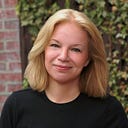Member-only story
Around the World in Books / Poland
Sexualizing Marie Curie
The Polish scientist gets naked in a National Book Award finalist. But do you gain anything from it?
This is the 20th post in the “Around the World in Books” series that is reviewing 30 books from 30 countries during the first 30 days of March. Tomorrow: Qatar
This book shows you Marie Curie as you’ve never seen her: naked.
In Radioactive: Marie & Pierre Curie: A Tale of Love & Fallout (HarperCollins, 2010), Lauren Redniss modifies the format of graphic novels as she focuses on the couple’s love affair with physics and with each other. She omits the usual strips or panels and encloses her text in haunting black-and-white, two-toned, or multicolored spreads.
Redniss works hard to show the importance of the Curies’ scientific achievements. She makes clear that radioactivity helped lead to modern events that range from the partial meltdown of two nuclear reactors at Three Mile Island to the cranial radiation treatments that enabled a 14-year-old Rhode Island boy to survive his non-Hodgkins lymphoma.
But a half dozen of the images unabashedly sexualize Marie: They show the two-time Nobel laureate as fully or partly nude. On one dramatic spread she frolics as…
